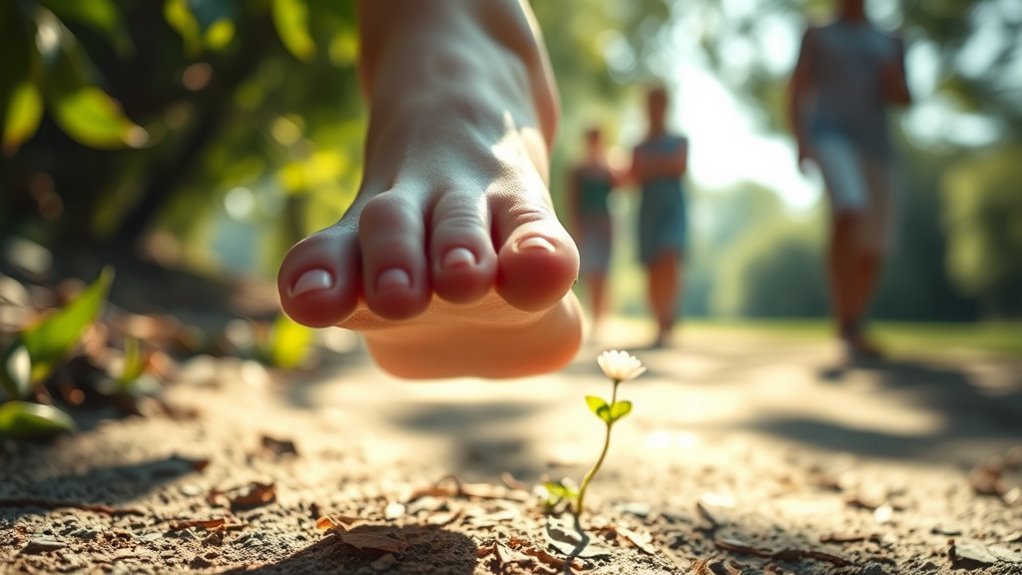11 Spiritual Meanings of Tripping and Falling
Have you ever wondered why you trip or fall? These moments may be more than simple accidents; they can signal you to stop and think about your journey. Each trip might carry a message, encouraging you to reflect on your fears, changes, and the need to stay grounded in the present. As you consider these meanings, you may find insights that support your personal growth.
Key Takeaways
- Tripping and falling often serve as reminders to slow down and reconnect with one's true self amidst life's chaos and distractions.
- These stumbles can symbolize necessary life transitions, urging individuals to assess their current path and embrace change.
- Falling may manifest underlying fears and anxieties, prompting opportunities for personal growth and resilience through vulnerability.
- Spiritual practices like mindfulness and grounding techniques can help individuals gain clarity and presence during these moments of misstep.
- Embracing the impermanence of life highlighted by stumbling fosters deeper connections and appreciation for experiences with others.
A Call to Pause and Reflect
Trips and falls can feel surprising. They often serve as a prompt to stop and think about your journey. When you stumble, pause and take a deep breath. This moment is an invitation to dig deeper.
Use self-reflection to explore your emotions. Ask yourself what this experience says about your path and goals. Mindfulness activities like meditation or grounding exercises can help you return to the present.
Every stumble teaches you about strength and being true to yourself. Embrace this chance to connect with who you really are. In moments of quiet, you'll find a sense of belonging, not just within yourself, but also with the larger universe.
Let each stumble guide you back to your true self.
Releasing Fear and Anxiety
When you stumble, it can bring up fear and anxiety about what comes next. Instead of resisting these feelings, use them as a chance to release fear and manage anxiety.
Here are three ways to help you feel calm:
- Breathe Deeply: Take a deep breath. Let it fill your lungs. Focus on the air coming in and going out. This keeps you present.
- Visualize: Imagine yourself overcoming challenges. See fear become strength and determination.
- Affirm: Say positive affirmations that resonate with you. Remind yourself that you aren't alone on this journey.
Embrace these moments. They can lead to personal growth and stronger resilience.
A Sign of Transition
Stumbles often indicate a change in your life's path. These small falls can signal important shifts, prompting you to reflect. When you trip, it offers a chance for personal growth.
These moments encourage you to stop and think about your direction. During these times, ask yourself what you need to let go of or hold onto. Your journey isn't always straightforward, and each misstep can teach you valuable lessons.
Welcome these changes as signs that guide your personal development. Remember, you're part of a larger picture, connected with others, moving through life's highs and lows together, and finding your place in this shared journey.
The Need for Grounding
As life moves quickly, moments of stumbling remind you of the importance of staying grounded. You may feel confused at times, but these slips encourage you to pause and reconnect with yourself.
Grounding techniques can help you find balance and strengthen your link to the earth. Here are three effective ways to ground yourself:
- Nature Walks: Spend time outside. Feel the ground under your feet and enjoy the natural environment around you.
- Meditation: Focus on your breathing. This can help you stay present and create a sense of calm.
- Journaling: Write down your thoughts and feelings. This helps you express your inner voice and clarify your goals.
These practices help you feel more connected and enhance your sense of belonging.
Lessons in Humility
Tripping teaches you the importance of staying grounded and offers valuable lessons in humility. Each fall prompts you to think about your limitations and encourages personal growth.
You recognize that perfection is an illusion; we're all imperfect beings sharing life's journey. Embrace moments when you stumble; they help you connect with your true self.
Acknowledging your vulnerability allows for deeper relationships and shared experiences. These lessons in humility prepare you to face life's unpredictability, reminding you that it isn't about avoiding falls but about learning to rise, laugh, and move forward together.
Let humility lead you to a sense of belonging.
An Invitation to Stay Present
When you stumble, pause to focus on the present. Small missteps can remind you to be mindful. Use this moment to connect with yourself and your surroundings.
Here are three simple ways to stay present:
- Breathe: Inhale deeply to center yourself now.
- Observe: Look around and use your senses to notice details.
- Reflect: Think about what this moment teaches you.
These steps can help you learn and grow. Each moment can offer valuable insights. Embrace this opportunity for growth.
The Universe's Way of Redirecting
Sometimes, a stumble can feel like a nudge from the universe, guiding you off a path that doesn't serve you anymore. These changes often appear as small accidents or missteps, prompting you to stop and reflect.
When you trip, think of it as a sign that the universe may be pointing you in a new direction, away from limiting choices and towards opportunities that align with your true self.
Embrace these moments as guidance, reminding you that life is fluid and constantly changing. Trust that each stumble brings valuable lessons and insights about your journey.
You aren't alone; the universe supports your growth. Let these reminders inspire you to realign with your true purpose and find your place in the natural flow of life.
A Warning Against Overconfidence
Even if you feel strong in certain areas of your life, remember that a fall can remind you to stay humble. These experiences help you see the risks of being overly confident.
Here are some lessons in humility to consider:
- Accept vulnerability: Understand that everyone falls; it's a normal part of being human.
- Stay mindful: Be present to reduce distractions that can lead to mistakes.
- Appreciate growth: Value both your successes and failures as chances to learn.
Stay grounded and embrace these lessons.
A Reminder of Life's Impermanence
Falling teaches humility and reminds us that life is fleeting. Each stumble makes you aware of impermanence and encourages you to accept this truth. When you lose your footing, you face the fact that nothing lasts forever. This realization can be both unsettling and freeing, helping you see the beauty in transience.
Cherish each moment, each connection, and every experience, no matter how small. Instead of fearing your falls, see them as chances to live more fully. Understanding life's delicate nature allows you to connect with others, creating a shared experience of resilience and understanding.
Connecting With Inner Strength
Every challenge you face can help you connect with your inner strength.
In these vulnerable times, you can start to empower yourself and discover your true capabilities. As you think back on your experiences, you can uncover feelings and insights that resonate with you.
Here are three steps to strengthen this connection:
- Pause and Breathe: Take a moment to center yourself and acknowledge your emotions. This helps you reflect.
- Reflect on Past Strengths: Remember times when you showed resilience. This recognition can highlight your inner power.
- Set Intentions: Prepare for upcoming challenges by understanding that every setback can lead to personal growth and strength.
Embrace your experiences, and you'll find a sense of belonging in your own journey.
Encouragement to Embrace Change
Change is a part of life. Embracing change can lead to personal growth and new experiences. When you accept uncertainty, you open yourself to new opportunities.
Each setback can remind you of your potential to grow. Embracing change means stepping out of your comfort zone and allowing yourself to thrive in new situations.
Remember, many others are also experiencing their own changes. Together, you can find support and strength in vulnerability.
Take a deep breath and view each change as an opportunity. Embrace your journey with confidence, and trust that these experiences will help you evolve.
Frequently Asked Questions
What Are Common Physical Causes for Tripping and Falling?
You might trip and fall for several reasons. Common causes include balance issues, poor footwear, or uneven surfaces. Check your shoes and ensure they provide support. Also, look around for obstacles like rugs or debris. Taking mindful steps and being aware of your environment can help you feel more confident and steady. A supportive community can also assist you in maintaining balance and safety.
How Can I Prevent Tripping in the Future?
To prevent tripping, practice balance exercises and mindfulness. These activities will help you become aware of your surroundings. Focus on each step you take to build a connection between your body and the ground. This will improve your confidence and stability. Enjoy your journey to better balance!
Are Certain Places More Likely to Cause Falls?
Certain places can create hazards that may lead to falls. Examples include uneven sidewalks, wet floors, and cluttered walkways. Staying aware of your surroundings helps reduce the risk of falling. Pay attention to your environment, and take care when moving through spaces where falls can occur. This awareness can lead to safer experiences and a better connection with the places you visit.
Can Stress Contribute to Physical Clumsiness?
Stress can affect your physical coordination. Managing stress can improve your awareness and balance. As you learn to calm your mind, you may notice better movement and a stronger connection to your body. Embrace this process for a positive change in your physical skills.
What Should I Do Immediately After Falling?
After a fall, ensure your safety first. Take a moment to check for injuries. If you feel pain or discomfort, stay still until help arrives. If you're okay, slowly get up. Use nearby objects for support if needed. Take a deep breath, and assess your surroundings. Remember, this experience reflects your strength and the importance of being cautious. Reach out for support from friends or family if you need it.

Liza Stockholm is an esteemed spiritual guide and the visionary behind Spiritual with Liza. With a profound passion for empowering others on their spiritual journey, Liza offers a blend of educational content and personal guidance. Her expertise in spirituality is rooted in years of dedicated practice and study, making her a trusted companion for those seeking enlightenment and inner peace.







